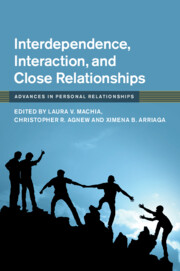16 results
Contents
-
- Book:
- Interdependence, Interaction, and Close Relationships
- Published online:
- 19 June 2020
- Print publication:
- 18 June 2020, pp vii-viii
-
- Chapter
- Export citation
Part II - Interdependence, Security, and Risk
-
- Book:
- Interdependence, Interaction, and Close Relationships
- Published online:
- 19 June 2020
- Print publication:
- 18 June 2020, pp 93-180
-
- Chapter
- Export citation
Copyright page
-
- Book:
- Interdependence, Interaction, and Close Relationships
- Published online:
- 19 June 2020
- Print publication:
- 18 June 2020, pp vi-vi
-
- Chapter
- Export citation
Part I - Interdependence, Situations, and Context
-
- Book:
- Interdependence, Interaction, and Close Relationships
- Published online:
- 19 June 2020
- Print publication:
- 18 June 2020, pp 9-92
-
- Chapter
- Export citation
Acknowledgments
-
- Book:
- Interdependence, Interaction, and Close Relationships
- Published online:
- 19 June 2020
- Print publication:
- 18 June 2020, pp xiv-xvi
-
- Chapter
- Export citation
Part III - Interdependence, Goal Pursuit, and Person Factors
-
- Book:
- Interdependence, Interaction, and Close Relationships
- Published online:
- 19 June 2020
- Print publication:
- 18 June 2020, pp 181-266
-
- Chapter
- Export citation
Tables
-
- Book:
- Interdependence, Interaction, and Close Relationships
- Published online:
- 19 June 2020
- Print publication:
- 18 June 2020, pp x-x
-
- Chapter
- Export citation
Part IV - Interdependence, Timing, and Expectations
-
- Book:
- Interdependence, Interaction, and Close Relationships
- Published online:
- 19 June 2020
- Print publication:
- 18 June 2020, pp 267-367
-
- Chapter
- Export citation
Figures
-
- Book:
- Interdependence, Interaction, and Close Relationships
- Published online:
- 19 June 2020
- Print publication:
- 18 June 2020, pp ix-ix
-
- Chapter
- Export citation
5 - An Interdependence Analysis of Enhancing Attachment Security
- from Part II - Interdependence, Security, and Risk
-
-
- Book:
- Interdependence, Interaction, and Close Relationships
- Published online:
- 19 June 2020
- Print publication:
- 18 June 2020, pp 95-119
-
- Chapter
- Export citation
Contributors
-
- Book:
- Interdependence, Interaction, and Close Relationships
- Published online:
- 19 June 2020
- Print publication:
- 18 June 2020, pp xi-xiii
-
- Chapter
- Export citation
Index
-
- Book:
- Interdependence, Interaction, and Close Relationships
- Published online:
- 19 June 2020
- Print publication:
- 18 June 2020, pp 368-370
-
- Chapter
- Export citation

Interdependence, Interaction, and Close Relationships
-
- Published online:
- 19 June 2020
- Print publication:
- 18 June 2020
3 - Interdependence Perspectives on Power in Relationships
- from Part I - Power in Close Relationships: Theoretical Perspectives
-
-
- Book:
- Power in Close Relationships
- Published online:
- 19 February 2019
- Print publication:
- 28 February 2019, pp 55-71
-
- Chapter
- Export citation
27 - Aggression and Violence in Romantic Relationships
- from Part VII - Threats to Relationships
-
-
- Book:
- The Cambridge Handbook of Personal Relationships
- Published online:
- 11 June 2018
- Print publication:
- 21 June 2018, pp 365-377
-
- Chapter
- Export citation
3 - Accommodation Processes During the Early Years of Marriage
-
-
- Book:
- The Developmental Course of Marital Dysfunction
- Published online:
- 13 October 2009
- Print publication:
- 13 August 1998, pp 74-113
-
- Chapter
- Export citation

